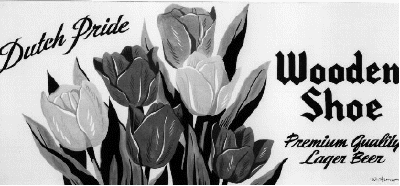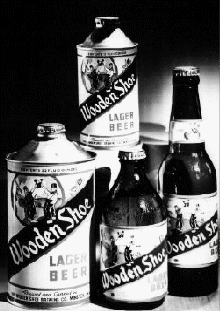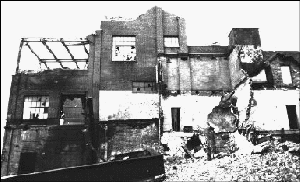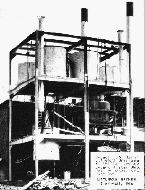
What do Albert Einstein, Henry Ford and Abraham Lincoln
have in common? They have all achieved a level of greatness that will not be easily
surpassed. With a little help, inanimate objects can do the same, and I believe the former
Wooden Shoe Brewing Company of Minster, Ohio, falls into this category.
Ask anyone in this West-Central Ohio community about the brewery and you should be
prepared to pack a lunch, as there are so many enjoyable stories to be heard. It brings
back vivid memories to everyone who lived in the area at the time. As you will see, this
was more than a small local brewery, it was a way of life for the residents who lived in
the vicinity. Wooden Shoe was the major employer in the Minster area, and from 1933 until
approximately 1943, the tax money from the brewery met the entire operating expenses of
the town.
Operating this brewery was not all fun and games, though. The business experienced many
hardships, such as a complete loss by fire, the death of the manager, prohibition, the
passing of the brew master, a shortage of materials, and finally, stiff competition from
the large national breweries. Let's go back and take a brief look at the history and
legacy of the local brewery.
It all began in 1869 with a man named Franz Lange constructing his brewery from stone
and brick. It was modeled after a lager beer brewery in Piqua, Ohio, (which would later be
purchased by the Lange family and named after them). There were two other breweries in
Minster at the time, one company was owned by George Luckman, and the other by Bernard H.
Nienberg; however, they both produced a "brown beer," that was not to the liking
of the townspeople. By 1870, the new beer began to flow, and Lange's brewery did well, as
the local brew was well received by the residents. Peter Mittler became brewmaster in 1875
and would hold that position 23 years until leaving in 1898. He would eventually sell his
ownership share to J.B. Meyer in 1899.
In 1883, the brewery was sold to the
Steineman brothers. It was in the same year, that German native Joe Brinkman would serve
an apprenticeship at the Wiedemann brewery in Newport, Kentucky. He was employed at the
Minster brewery in 1884 as a cellarman, and would eventually become a key part of the
business.
Business went well until a fire leveled the building on June 28, 1888. It was
rebuilt in 1890, and was once again sold on Nov. 5, 1890. The five men forming the new
company were: Peter Mittler, Matt Goeke, A.W. Gerwals, Ben Frierott, and Frank Herkenhoff.
Over the next 13 years, there was a period of modernization, including the installation of
a new beer cooling system and some expansion. Bottles were still filled and capped by hand
as late as 1892, but this method was discarded the following year and a modern machine
that washed, filled and capped faster and better than before, was put into service.
In 1895, there was a complete renovation, and the main building was expanded with the
addition of a 40 x 80 foot cellar on the East side. Upon Peter Mittlers' departure in
1898, Joe Brinkman took over as brewmaster. He had the respect and admiration of everyone
who knew him. His reign would last until his death. On October 31, 1901, they bought a new
ice machine and installed a 100 hp steam engine. There was a constant upgrade of
equipment.
A dramatic turn of events took place on May 26, 1903, when manager Ben Frierott Sr.
died. The decision was made to disband the old company, and form a new one with new
management. The name of the brewery was changed to the Star Brewing Company on July 1,
1903.

A dramatic turn of events took place on May
26, 1903, when manager Ben Frierott Sr. died. The decision was made to disband the old
company, and form a new one with new management. The name of the brewery was changed to
the Star Brewing Company on July 1, 1903. J.B. Meyer sold his interest to Frank
Herkenhoff. The members of the board of directors were as follows: Matt Goeke - President,
Frank Herkenhoff Sr. - Vice President, Charles Herkenhoff - Secretary/Treasurer &
Manager, A.W. Gerwals & George Van Oss served as directors.
In July of 1907, Van Oss
stepped down, and he was replaced by Anton Frierott. At this point, Star Brewing was a
leading brewer with an annual output of 15,000 barrels per year. The incorporated company
had started with $1,000 worth of capital, and consisted of the brewery, several buildings,
ponds, an ice house, and a warehouse in at least eight surrounding communities. A 100 hp
and a 20 hp steam engine were installed to process grain. Two artesian wells were drilled
to supply the needed water, and a generator took care of the electric needs of 60 lights
in the entire plant. This was one of the most modern breweries in the country. It was also
one of the highest buildings in Minster, and was very efficient because the brewing
process started at the top with the grinding of the grain, and continued downward with the
help of gravity. The various ingredients were added along the way. There was no need for
pumps or other elaborate equipment.
There were no tractor trailers or route trucks to deliver beer in the early 1900's, but
instead there were five wagons and teams of horses. They were busy year round. There were
twenty-five employees back then, with a monthly payroll of $1,000 -- $1,500.
The brewing came to a screeching halt when prohibition was enacted in 1919, and Star Brewing was forced to lay off some employees. However, eight
to ten remained and kept the business running with a new line of soft drinks and near
beer. A home malt tonic was also introduced which claimed to be of use to nursing mothers,
frail children, convalescents, the elderly, and for all who were run down or had nervous
conditions. Picture an old bearded man with a top hat, standing on his soap box, giving
the big sales pitch! Local residents and former employees reported that the low alcohol
stuff was the same brew as the pre-pro drink. Maybe this accounts for the raid by F.B.I.
officials in December 1921, when the brew was discovered to have an alcohol content of
3.33 %, when the legal limit was less than 1%. The brewery also sold ice that they cut
from their ponds, and did anything to keep the doors open.
By this time, the name had changed to the Star Beverage Company. They survived
prohibition with the new products, and when repeal came along in 1933, the brewery took
off again. They enjoyed a rapid sales increase, and once again business was booming. The
beer from the small brewery was shipped throughout most of the United States, either by
rail or truck, and in later years, by a distributor network. There were approximately 50
distributors in Indiana, Michigan, Missouri, New York, Ohio, and West Virginia.
The
original brewery building on the right with the newer addition on the left.

In 1935, the brewery doubled its floor space, and
production went up accordingly. The following improvements were necessary: A new brew
house, stock house and fermenting cellar. Star Beverage was the first union shop in town,
and also was the first in town to strike. In 1940, the name was changed to the Wooden Shoe
Brewing Company. Anton Frierott served as manager for many years, and upon leaving, was
succeeded by his son Harold. In 1942, longtime brewmaster Joe Brinkman died, and was
followed by Mike Hartman. Hartman had been superintendent since 1903, and one of his
responsibilities was to take care of the boilers. In later years, Hartman was replaced by
Richard Frierott, another son of Anton.
Wooden Shoe had its own waste disposal plant long before
the town had one of its own. When Minster built its plant, council asked them to hook up
to the town's plant because the brewery had large amounts of mostly clear, uncontaminated
waste water that the town needed. They initially hooked up at no charge, but later the
town started charging the brewery a fee for disposal. Eventually, the brewery was paying
over half of the cost of the whole town's disposal. Feeling that this amount was a bit
excessive, they talked to other breweries like Anheuser-Busch, to see what they were
paying. Most of the other breweries were paying in the neighborhood of $1,000 per year,
while Wooden Shoe was assessed for around $500 per month. This did not help the situation
that would follow.
Prior to W.W.II, the larger national breweries had expanded, but due to the war, there
was a shortage of ingredients. The rationing of these ingredients kept the large breweries
from coming into the area. Wooden Shoe even reused the bottle caps, because metal and cork
were in short supply as well. They experienced a lot of leakers due to the cork
deteriorating. When the war was over, the Frierott family saw the writing on the wall.
They knew that it was only a matter of time before they would be overrun by the
competitors. Wooden Shoe had lost much of their distributor network, because they could
not supply the volume that the customers demanded.
The
Wooden Shoe building is shown below during a phase of its destruction.

Financier Ulreh Vogt of Chicago approached Wooden Shoe
about selling. He needed beer for his wholesale business back home. This seemed like a
good idea to the Frierotts, and on August 16, 1946 the brewery was sold once again. In
1947, Vogt made a big push including a large advertising blitz. He put up billboards, had
ads on radio, and even sponsored the Dayton Ducks (formerly a Dayton, Ohio minor league
baseball team). They also spent thousands of dollars for newspaper ads in the area. The
advertising budget was one dollar per barrel of beer sold. On May 16, 1947, 300,000 shares
of stock were made available to the public, as part of the company's re-capitalization and
expansion plan. On September 14, 1948, the first stockholder's meeting took place. The
value of the stock was approximately $5.00 per share.
Sales at that time topped $1,781,000 and there were 77 employees. Maximum capacity was
150,000 barrels per year. Still feeling the effects from the shortage of grain, Vogt
introduced some substitutes like manioc to boost production. The problem was, with the
introduction of these substitutes, the beer had a tendency to become unstable, which did
not sit very well with customers. Wooden Shoe had always maintained the highest quality
standards, but with the latest product becoming "skunky," a decrease of business
soon followed. It was hard to get the distributors back too, because they had developed
new relationships with some of the larger brewers like Hudepohl, Miller, Schoenling,
Wiedemann etc. The other brewers were not hurt as much by the rationing, because their
allocation of ingredients was higher. They could provide more beer than a smaller brewery.
As the effects of W.W.II wore off, and shortages were over, Wooden Shoe had recovered some
of their distributors, but could not be compared to the number prior to the war.
Vogt, who also owned Consumers Brewery in Newark, Ohio, poured $125,000 into his
venture to cover deficits, but to no avail. The brewery continued to experience a steady
decline, and by 1950 had weakened considerably. Harold Frierott left in 1950, along with
his brother Richard, to start up their own distributorship. Harold was replaced by B.
Harrison Neuman, who was then replaced by Frank Piening in 1952.
Compact
100 barrel Littleford Brew House at the Star Beverage Company, Minster, Ohio.
Home
of Wooden Shoe Lager.

Vogt had contacted several larger brewers to see if they
were interested in the brewery, including Anheuser-Busch. There was no interest. The
company was placed into receivership on August 20, 1953, with Frank Piening being named as
receiver by federal district court in Toledo. On November 17, 1953, the court ordered the
brewery to cease operations. Vogt was to come up with a plan of reorganization, and
present it in detail at a hearing on February 15, 1954. He was not ready, and therefore an
extension was given until March 4, 1954. The extra time allowed had no results, and
therefore a meeting of the creditors was held on March 25, 1954. There was an auction
planned for June 24, 1954, and It was reported that the building and equipment brought
only $50,000.
The man that bought the building was a junk dealer, and you guessed it -- he completely
gutted the place. The beautiful copper and brass railings, vats and lines were all
removed. Anything of value was taken out. What else were they to do with a building that
had become obsolete? It really makes a person dream today. It would have been a perfect
place for a micro brewery and a restaurant. After the brewery was sold once again, it was
converted into a cannery. In later years it was used as a warehouse by several different
companies. Another sale took place in the spring of 1990, and on May 24, the new owner
started razing the structure. A large metal building now stands where the brewery once
stood. Memories are all that remain, including the goldfish pond out front, underage kids
sneaking in and getting beer, the wedding receptions in the rathskeller, the employees
spiking the kegs of beer for their own use during prohibition, and much, much more.
Fortunately for collectors like myself, there was a lot of Wooden Shoe advertising
made, and new examples of this turn up from time to time. I have collected the local
breweriana for 20 years, and I know that I have only scratched the surface. With Mr. Vogt
passing away a number of years ago, I am sure that we will never know how much was made,
but that is what makes our hobby fun! A person will rarely get one of everything that was
made, but then I guess we will never know, will we?
[ Back to Industry Index ] |

